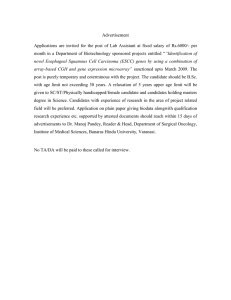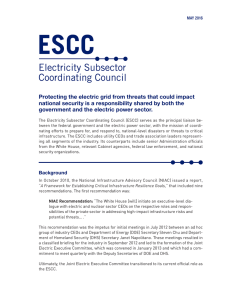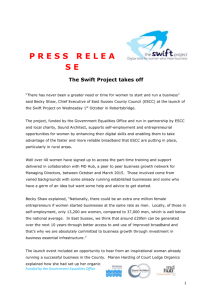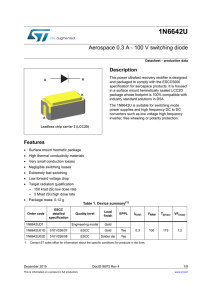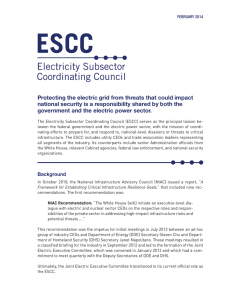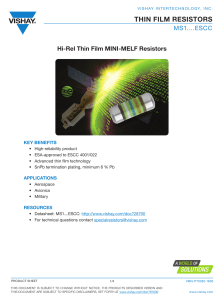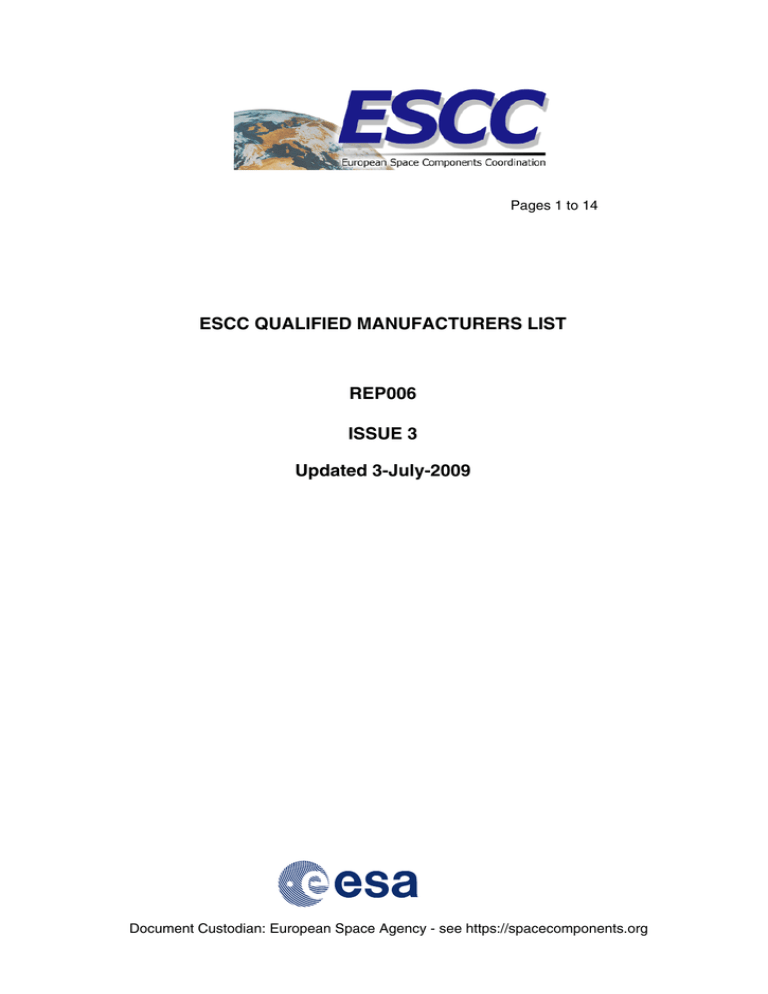
Pages 1 to 14
ESCC QUALIFIED MANUFACTURERS LIST
REP006
ISSUE 3
Updated 3-July-2009
Document Custodian: European Space Agency - see https://spacecomponents.org
REP006
PAGE 2
ISSUE 3
LEGAL DISCLAIMER AND COPYRIGHT
European Space Agency, Copyright © 2009. All rights reserved.
The European Space Agency disclaims any liability or responsibility, to any person or entity,
with respect to any loss or damage caused, or alleged to be caused, directly or indirectly by the
use and application of this ESCC publication.
This publication, without the prior permission of the European Space Agency and provided that
it is not used for a commercial purpose, may be:
–
–
copied in whole, in any medium, without alteration or modification.
copied in part, in any medium, provided that the ESCC document identification, comprising
the ESCC symbol, document number and document issue, is removed.
REP006
PAGE 3
ISSUE 3
DOCUMENTATION CHANGE NOTICE
(Refer to https://escies.org for ESCC DCR content)
DCR
No.
CHANGE DESCRIPTION
528 Document updated to introduce new variants to Vishay Technology Flow per DCR.
REP006
PAGE 4
ISSUE 3
FOREWORD
This document contains a list of qualified manufacturers that have been certified by the
European Space Agency for Technology Flows to the rules of the ESCC System with principle
reference to ESCC Basic Specification No. 25400.
The qualified electronic components produced from the Technology Flows are intended for use
in ESA and other spacecraft and associated equipment in accordance with the requirements of
the ECSS Standard ECSS-Q-60.
Each Technology Flow qualification and its subsequent maintenance is monitored and
overseen by the ESCC Executive. ESA certifies the qualification upon receipt of a formal
application from the Executive stating that all applicable ESCC requirements have been met by
the pertinent manufacturer. The qualified status of a Technology Flow is noted by an entry in
this document, a corresponding entry in the European Space Components Information
Exchange System, ESCIES, and the issue of a certificate to the qualified manufacturer.
REP006
PAGE 5
ISSUE 3
TABLE OF CONTENTS
FOREWORD
4
1.
PROMOTION
6
2.
PROCURER’S RESPONSIBILITY
6
3.
QML ORGANISATION
6
3.1
3.2
3.3
3.4
3.5
Technology Flows
Qualified Components
Type Designation
Component Characteristics
Manufacturer
6
6
6
6
6
4.
REVISION PROCEDURE
7
5.
QUALIFIED TECHNOLOGY FLOWS
7
5.1
5.2
Atmel
Vishay Sfernice France
7
12
REP006
PAGE 6
ISSUE 3
1.
PROMOTION
It is permitted to advertise the ESCC qualification status of a component provided such publicity
or advertisement does not state or imply that the component is the only qualified one of that
particular type, range or family.
2.
PROCURER’S RESPONSIBILITY
When procuring ESCC qualified components, the procurer is responsible for ensuring that the
qualification status is valid and that delivered components fulfil the specified requirements of
the applicable ESCC specifications. The procurer is advised to utilise the ESCC nonconformance system, per ESCC Basic Specification No. 22800, in the event that a qualified
manufacturer delivers non-conforming components.
3.
QML ORGANISATION
3.1
TECHNOLOGY FLOWS
The individual Technology Flows are listed in this document by manufacturer in alphabetical
order. They may also be found on the ESCIES web site, https://escies.org.
The controlling ESCC specifications are identified and a Technology Flow Abstract is provided
to describe the main features of the qualified Technology Flow.
3.2
QUALIFIED COMPONENTS
Under each technology flow a list of the qualified components is provided. As new components
are specified in an ESCC Detail Specification and are produced within the Technology Flow the
list will be updated accordingly.
3.3
TYPE DESIGNATION
Wherever possible the referenced type (style) designations are derived from industrial
standards (i.e., JEDEC, PRO-ELECTRON, MIL, IEC and CECC). The purpose is to identify the
similarity of a listed qualified component, to a standard type designation. Where no
standardised type designation is applicable the manufacturer’s designation is referenced.
3.4
COMPONENT CHARACTERISTICS
The electrical characteristics described in the Technology Flow Abstract are provided for
guidance only and, unless otherwise stated, are specified at +25oC. The precise characteristics
of the qualified component are defined in the referenced ESCC specifications.
3.5
MANUFACTURER
Contact information and plant locations are indicated in the individual Technology Flow listings.
Contact information may also be found in the ESCC QML section of the ESCIES web site,
https://escies.org.
REP006
PAGE 7
ISSUE 3
4.
REVISION PROCEDURE
Amendments to earlier issues of the ESCC QML, implemented herein, are indicated by the
issue date and by the content of the relevant “Document Change Request”.
5.
QUALIFIED TECHNOLOGY FLOWS
The following Technology Flows are qualified:
5.1
ATMEL
Contact Information
Address
ESCC Chief Inspector
Atmel Nantes
BP 70602
44306 Nantes Cedex 3
France
Mr C. Ferré
Tel. +33 24 01 81 913
FAX +33 24 01 81 946
Initial Qualification
Qualification
Certificate No.
Validity
Dates
Type Designation
278
Dec. 2006 Dec. 2008
Integrated Circuits, Silicon Monolithic, CMOS Gate/
Embedded Array based on type MH1RT
Maintenance of Qualification
Qualification
Certificate No.
Validity
Dates
Comment
Applicable Documents
ESCC Generic Specification No. 9000
ESCC Detail Specification No. 9202/076
Atmel Process Identification Document PID 0026
REP006
PAGE 8
ISSUE 3
List of Qualified Components
For each ASIC design an ASIC Sheet is produced by Atmel for use in conjunction with the
ESCC Detail Specification No. 9202/076. Where the ASIC is not proprietary to the customer the
ASIC sheet is published in ESCIES as a supporting document. Availability of the ASIC sheet is
indicated in the table by an * in the final column.
ASIC Sheet Component Type
ESCIES
FPK
*
Integrated Motor Controller for Mechanisms
Technology Flow Abstract
1.
Technology Flow
The MH1RT gate array family is designed with a 0.35μm radiation tolerant CMOS
technology. The offering is based on a 4 metal layer 3.3volts AT56KRT process.
The family features arrays with up to 1.6 million routeable gates and 596 pads. The MH1RT
is suitable for high speed, low power digital applications working in a radiation intensive
environment.
The Technology Flow covers the foundry design, fabrication, assembly and testing of the
MH1RT Sea of Gates family.
Scope
Site
Design Centre
Array Sizes:
- 99K
- 156K
- 242K
- 332K
- 3V and 5V tolerant/compliant
Atmel Nantes
BP 70602
44306 Nantes Cedex 3
France
Wafer Fabrication
Process Flow: AT56KLRT
Atmel Rousset
Zone Industrielle
131106 Rousset Cedex
France
Assembly
Packages:
- Multilayer Quad Flat Pack
196, 256, 352 pins
- Multilayer Column Grid Array
349, 472 pins
E2V Grenoble
BP 123
38521 Saint-Egrève Cedex
France
REP006
PAGE 9
ISSUE 3
Test
Scope
Site
Lot Formation
Wafer Acceptance Inspection
- SEM
- Wafer Lot Acceptance
In-process Inspection
Test
Testing Flow
Sampling Plans
Test Procedures
- Test Vector Generation
- Test Program Validation
Customer Source Inspection
Qualification Testing
Lot Acceptance
Support Qualification Test Plan/Report
Technology Characterization
Reliability Monitoring
Atmel Nantes
BP 70602
44306 Nantes Cedex 3
France
Incoming Inspection
Final Test
- Credence, Type Octet
Screening
External Visual Inspection
MHS Nantes
92, route de Gachet
La Chantrerie
BP60601
44306 Nantes Cedex 3
(a) Basic Information
– 0.35μm CMOS technology AT56KRT Process.
– High Speed Performance
•
170 ps typical gate delay (NAND, fanout 2) @ 3V
•
800 MHz typical toggle frequency @ 3.3V
–
Triple Supply Operation
•
3.3, 3 and 2.55 V operation
•
5V compliant
•
5V tolerant
–
Low Supply Current
•
Operating Maximum Value
0.32 μW/gate/MHz @ 2.5V,
0.54 μW/gate/MHz @ 3V,
0.69 μW/gate/MHz @ 3.3V
•
Maximum Stand-by Value
4nA/gate@ 2.5V
5nA/gate@ 3 and 3.3V
–
–
472 pins maximum (MCGA 472 package)
I/O Interface
•
CMOS, LVTTL, LVDDS, PCI, USB
•
Output Currents Programmable from 2 to 24 mA, by Steps of 2 mA
•
Cold Sparing Buffers (2μA maximum leakage current at 3.6V and 125oC)
REP006
PAGE 10
ISSUE 3
–
Radiation
•
qualified to 1000 Gy(Si) letter R per ESCC Basic Specification No. 22900,
tested successfully to 2000 Gy(Si)
•
No Single Event Latch-up below a LET Threshold of 70 MeV/mg/cm2
•
SEU Hardened Flip-flops
–
Four Arrays and Four Composite Arrays
•
Device Types
Refer to ESCC Detail Specification No. 9202/076
(b) Component Types
This table presents the available couples (array, package) as defined in the Variants
table in the Detail Specification.
TH1099E
TH1156E
TH1242E
TH1332E
TH1M099E
TH1M156E
TH1M242E
TH1M332E
99K
156K
242K
332K
MQFP-T352
X
X
X
X
MQFP-F256
X
X
X
MQFP-F196
X
X
X
X
X
Array Designation
Array size
Package
MCGA 472
MCGA 349
2.
X
X
Design
The design manual and the ASIC library data books cover design at the Atmel Nantes
Design Centre.
– MH1RT Design Manual ATD-TS-LR-R0232
– MH1RT 2V5 ASIC Library Data book ATD-TS-LR-R0236
– MH1RT 3V ASIC Library Data book ATD-TS-LR-R0235
– MH1RT 3V3 ASIC Library Data book ATD-TS-LR-R0238
ASIC designs are performed by the Atmel customer at their own site, with Atmel supported
tools (front end) provided as a design tool kit.
3.
Fabrication
The AT56KRT Radiation Tolerant process at Atmel Rousset is a 0.35μm CMOS, 4 metal,
Ti, TiN and AlCu process.
4.
Assembly
Atmel Nantes assembles the MH1RT devices at E2V Grenoble.
This Technology Flow covers the following capabilities.
REP006
PAGE 11
ISSUE 3
Package
Die Attach
Wire Bond
Lid Seal
Leads
MQFP
Silver Glass
(QMI2569)
Ultrasonic
Wedge, 32 μm Al
Brazed Sealed
with Au/Sn Alloy
Au Plated
MCGA
MCGA Cyanate Ester
(JM7600)
Ultrasonic
Wedge, 32 μm Al
Brazed Sealed
with Au/Sn Alloy
Sn/Pb
5.
Test
TCVs and SEC
The TH1156E matrix is used for both test vehicles.
(a) Test Vehicle V37
The V37 is a buffer test vehicle representative of the range of buffers available for
performance testing in the MQFP 256 package.
(b) Test Vehicle V38
The V38 is developed for performance and radiation testing in the MQFP 256 package.
It tests the following library elements;
– LVDS input and output buffers
– PCI 3V and 5V output buffers
– PLL (125 MHz and 250 MHz)
– DPRAM memory cell for GENESYS tool
(c) SEC
The standard evaluation circuit for reliability testing is the 65609E.
6.
Radiation Characteristics
The MH1RT family has been developed to fulfil the following characteristics in terms of
radiation tolerance:
– Tested up to 2000 Gy(Si)
– No Single Event Latch-up below a LET Threshold of 70MeV/mg/cm2
– Availability in the library of SEU hardened cells
The radiation capability of the MH1RT family has been tested during development and
evaluated in total dose and for single event effects to confirm the stated characteristics.
Lot radiation verification testing is performed if specified by the procurer’s purchase order
requirements.
REP006
PAGE 12
ISSUE 3
5.2
VISHAY SFERNICE FRANCE
Contact Information
Address
ESCC Chief Inspector
Vishay S.A.
Division Résistances de Très
Haute Précision
199, Boulevard de la
Madeleine
B.P. 1159
06003 Nice Cedex 1
France
Mr. E. Quehen
Tel: +33 4 93 37 27 27
FAX: +33 4 93 37 27 26
EMAIL: Erwan.Quehen@vishay.com
Initial Qualification
Qualification
Certificate No.
Validity
Dates
Type Designation
287
Feb. 2009 Feb. 2011
Thin Film Technology for Chip, Wraparound, Single and
Network Resistors, Fixed, Based on Types P for Single Chip,
PRA and CNW for Resistor Networks
Maintenance of Qualification
Qualification
Certificate No.
Validity
Dates
Comment
287A
Feb. 2009Feb. 2011
CNES application no. 287A and DCR 528.
Applicable Documents
ESCC Generic Specification No. 4001
ESCC Detail Specification Nos. 4001/023, 4001/025
Vishay Process Identification Document PID PID-TFD P PRA CNW
List of Qualified Components
REP006
PAGE 13
ISSUE 3
Variant No. By Form
Factor
Component Type
ESCC Detail
Specification
01, 05 and 09
P 0603 HR
4001/023 (1)
02, 06 and 10
P 0805 HR
4001/023 (1)
03, 07 and 11
P 1206 HR
4001/023 (1)
04, 08 and 12
P 2010 HR
4001/023 (1)
01 to 07 and 22 to 28
PRA 100 HR
4001/025
08 to 14 and 29 to 35
PRA 135 HR
4001/025
15 to 21 and 36 to 42
PRA 182 HR
4001/025
NOTES:
1. Note that gold finish variants are not intended for de-golding and tinning.
Technology Flow Abstract
1.
Technology Flow
The thin film technology for chip, fixed, wraparound, single and network resistors are
designed on types based on P for single chip, PRA for 2 to 8 resistors of similar value and
CNW for 2 to 8 resistors with at least two different values with the same form factor as PRA.
Technology Flow
Scope
Site
Design Centre
Single resistor chips in 0605, 0805, 1206
and 2010 formats
2 to 8 resistors of similar value in formats
0603, 0805 and 1206
2 to 8 resistors with at least 2 different
values with the same form factor, 0603,
0805 or 1206
Vishay S.A.
Division Résistances de
Très Haute Précision
199, Boulevard de la
Madeleine
B.P. 1159
06003 Nice Cedex 1
France
Fabrication
Film deposition
Photolithography
Thermal treatment
Passivation
Thermal stabilization and control
As above
Assembly
Laser trim
Protective layer
Termination and Test
As above
Test
Chart 2, 3 and 4
Periodic Testing
As above
(a) Basic Information
The technology consists of:
– Substrate: High purity alumina (99.5%)
– Resistive Layer: Nickel chromium
– Protection: Silicon Nitride
REP006
PAGE 14
ISSUE 3
–
–
–
Termination: Nickel barrier
Processes: Thin film deposition
Finish: SnPbAg or Au
Critical resistance by style:
– P 0603: 12.25 kΩ
– P 0805: 45 kΩ
– P 1206: 40 kΩ
– P 2010: 45 kΩ
– PRA 100: 12.25 kΩ
– PRA 135: 56.25 kkΩ
– PRA 182: 100 kΩ
(b) Component Types
The available formats are defined in the variants table in the Detail Specifications.
2.
Design
The design manual covers the design rules and limits:
– HP-BE/001 (Maîtrise de la conception)
– HP-BE/004 (Données technologiques, Régles d’implementation, Performances)
Critical design characteristics:
– Minimum metal width: 10μm
– Power dissipation lower than 250mW/mm2
– Current density lower than 7000 A/mm2
– Electrical field lower than 5V/μm
3.
Fabrication/Assembly
The manufacturing flows and procedures are described in section 4 of Vishay PID.
4.
Test
Complete test sequence as detailed in ESCC Generic 4001 and the relevant Detail
Specifications is conducted by Vishay Sfernice.
The deletion of the Third Harmonic Control requirement from ESCC Detail Specification
No. 4001/023 for thin film wraparound technology is documented in reference report MAT/
3HC/07.02 revision 3 dated 2007-06-20.
The efficiency of the Overload Test is increased with the implementation of a resistance
change rejection criteria of 500 ppm and approved by TRB decisions on 2007-04-04.
5.
Radiation Characteristics
The resistors covered in this technology domain is considered insensitive to radiation
effects.

